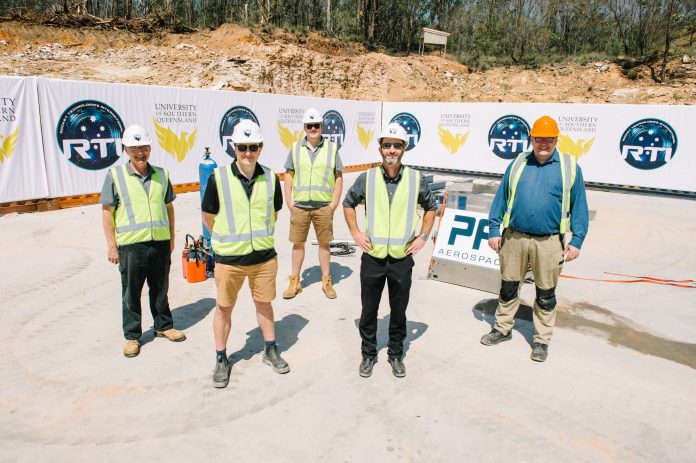
Media Release
In a giant leap for Australian space research, the first privately-owned, static rocket testing site has been developed in a partnership between Rocket Technologies International and the University of Southern Queensland.
A sandstone quarry is now the home of the Helidon Rocket Test Site, allowing developers to test rockets that are secured to the ground in a controlled environment.
Executive Director of University of Southern Queensland’s Institute for Advanced Engineering and Space Sciences, Professor Schubel, said it was the only facility of its kind in Australia outside of the Defence Forces.
“Rocket Technologies International and the University of Southern Queensland has partnered in order to build capacity for Australia, to develop the space industry and support fledgling rocket manufacturing companies so that they can enter the space race, advance technologies and sovereign capability,” Professor Schubel said.
“Through this partnership, we have been able to deliver this site for both research purposes and for commercial testing.”
The new precinct already has one horizontal test bed, rated to 200kN, which is used to verify the functionality and performance of the rockets (tested while secured in a fixed position on the test pad).
The fundamental data collected from these tests includes thrust, combustion pressure and casing temperature and provides critical information required for development of rocket technologies and trajectory modelling so that a launch test can be approved.
Professor Schubel said it was a pivotal and important step in Australian space research.
“We have entered what is being called The Space Race 2.0,” he said.
“We have the Moon to Mars mission coming out of NASA and there is a lot of commercial interest around space exploration as well.
“This is mainly around satellite communication systems, so there is a need for satellites to go up in the next 5-10 years and Australia is in a very strong position to support that activity.”
Owner of Rocket Technologies International and the Helidon quarry site, Allan Payne, is excited to be part of this next development.
“I am investing in space research as it is the future. The opportunities are endless,” he said.
“The relationship we have with the University of Southern Queensland is second to none and the most important thing is educating the future generation.”
For University of Southern Queensland Senior Research Fellow, Dr Fabian Zander, who researches rockets and hypersonic flows, the new facility provides the opportunity for world-class testing.
“It is unprecedented in Australia to have this type of access and we can bring ourselves, our fellow researchers and students down here to gain practical experience with the work that we are doing,” Dr Zander said.
“Internationally, the space industry is booming. A large part of that is propulsion, including rocketry and high-speed flight, so we are looking at the fundamentals of that, constructing capability within Australia and educating a new generation of people to work in that field.”
Nick Green, CEO of PFI Aerospace, is one of those space industry representatives already utilising the site.
“This site is a purpose-built site, with excellent facilities and geographically ideal for the majority of Australia’s rocket manufacturing industry. Australia needs sites like this if we are going to get involved more in the space industry. It is a critical piece of infrastructure,” he said.
The facility is another component of the University of Southern Queensland’s expansive space research.
The Helidon Rocket Test Site joins the University’s Mount Kent Observatory, the state’s only professional astronomical research facility.
“Our research is outcome-driven. We are working with industry to focus on solving problems and help answer the big questions,” Professor Peter Schubel said.




















